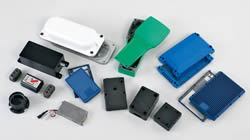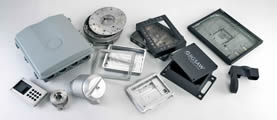The casting process implements a steel mold often capable of producing tens of thousands of castings in rapid succession. The die must be made in at least two sections to permit removal of castings. The casting cycle begins with the two die halves are clamped tightly together by the die casting press. Molten aluminum is injected into the die cavity where it solidifies quickly. These sections are mounted securely in a machine and are arranged so that one is stationary while the other is moveable. The die halves are drawn apart and the casting is ejected.
Die casting dies can be simple or complex, having moveable slides, cores, or other sections depending on the complexity of the casting. Most machines use mechanisms actuated by hydraulic cylinders to achieve locking. Others use direct acting hydraulic pressure. Die casting machines, large or small, very fundamentally only in the method used to inject molten metal into the die.
What Are The Advantages Of Aluminum Die Casting?
There are many reasons aluminum is the most commonly cast non-ferrous metal in the world. As a lightweight metal, the most popular reason for utilizing aluminum die casting is that it creates very lightweight parts without sacrificing strength. Aluminum die casting parts also have more surface finishing options and can withstand higher operating temperatures than other non-ferrous materials.
Aluminum die cast parts are corrosion resistant, highly conductive, have a good stiffness and strength-to-weight ratio. The aluminum die casting process is based on rapid production that allows a high volume of die casting parts to be produced very quickly and more cost-effectively than alternative casting processes. Aluminum die casting has become the favored option for buyers worldwide. Characteristics and Advantages of Aluminum Die Castings include:
- Lightweight and Durable
- Good Strength-to-Weight Ratio
- Great Resistance to Corrosion
- Excellent Electrical Conductivity
- Fully Recyclable and Reusable in Production
Aluminum Die Casting Product Segmentation
The popularity of aluminum has expanded to many applications around the world today, driving competitive market shares primarily for its distinctive features such as lightweight; corrosion resistance, high electrical and thermal conductivity, high stability for complex shapes and high tensile strength. The transportation sector is the largest end-use segment for this industry. The increasing emission laws by the government regulatory authorities, along with consumer demand for a higher fuel-efficient vehicle is developing a necessity for aluminum casting. An example of increased operations for the industry includes the replacement of iron and steel components in a vehicle with lightweight high-quality aluminum in order to increase the fuel efficiency. The aluminum die casting product is ideal for electronic connectors and housings die to its excellent electrical performance and shielding properties, even in high-temperature environments.
Another sector regarding the aluminum die casting demand includes building and construction in developing economies particularly in the Asia Pacific region. Aluminum Die Casting is associated with the creation of products including windows, cladding, curtain walling, prefabricated buildings, shop partitions, and fittings. Also, aluminum die casting products are used in aerospace operations or airplanes all around the world. The aerospace industry wants to produce a denser and larger quality product at lower costs for these air-frame components as aircraft continue to grow in size along with population rates.
According to Transparency Market Research, the Asia Pacific region accounts for over the half the share in the global market for aluminum castings. In the years ahead, the region is expected to further increase its share by pulling in the maximum Compound Annual Growth Rate of 5.3% during the forecast period between 2017 and 2025, and the powerhouse of China taking most of the credit. This market region is expected to become US $22.67 bn by 2025. Another important driving force includes the regions of Europe and North America in the global market for aluminum castings. While Europe is expected to register a Compound Annual Growth Rate of 5.1% during the forecast period to become worth US $9.45 bn, and the North America regions is expected to rise at a Compound Annual Growth Rate of 4.9% to become worth US $4.22 bn by the end of the year 2025. The statistics provided in this article express the importance in future Aluminum Die Casting growth for global production needs.
If you have requirement of aluminum die casting parts, I recommend you to visit Champion H&C Inc. – they are the professional aluminium die casting manufacturer in Taiwan. With years of experience, they can provide and custom best-quality die casting products for customers. Now, contact with Champion H&C to get more information of die casting services!
Article Source: https://www.phbcorp.com/what-is-aluminum-die-casting/



